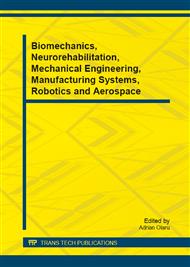p.33
p.39
p.45
p.57
p.63
p.68
p.74
p.80
p.85
Contribution to Analyze and Modeling of the Hand
Abstract:
The importance of joint integrity is a priority of the hand and wrist joints mobility is crucial for any individual. Motion control is achieved by the somatic nervous system composed of those formations which are designed to integrate body in the external environment, to achieve body relationship with this environment. Dynamic biomechanical models serve for quantitative analysis required in planning surgery on tendons [6] or to assess the transfer of nervous signals controlling the effectors [5]. Some others are dedicated to model various operations for design and implementation of the prosthetic components [13]. Recent models have approximately the same configuration: changing dimensional structure is not taken into account, but only the resulting physiological movement and rotation are analyzed for a single predominantly degree of freedom around a defined axis. Many scientists have tried over time to reproduce the hand kinematics, but not so many are those who have tried to design a guiding hand mechanism to reproduce its natural movements. The aim of this paper is to achieve the cinematic scheme of such a mechanism, able to lead fingers on path as possible as close to their natural movements.
Info:
Periodical:
Pages:
63-67
Citation:
Online since:
December 2012
Authors:
Price:
Сopyright:
© 2013 Trans Tech Publications Ltd. All Rights Reserved
Share:
Citation:


